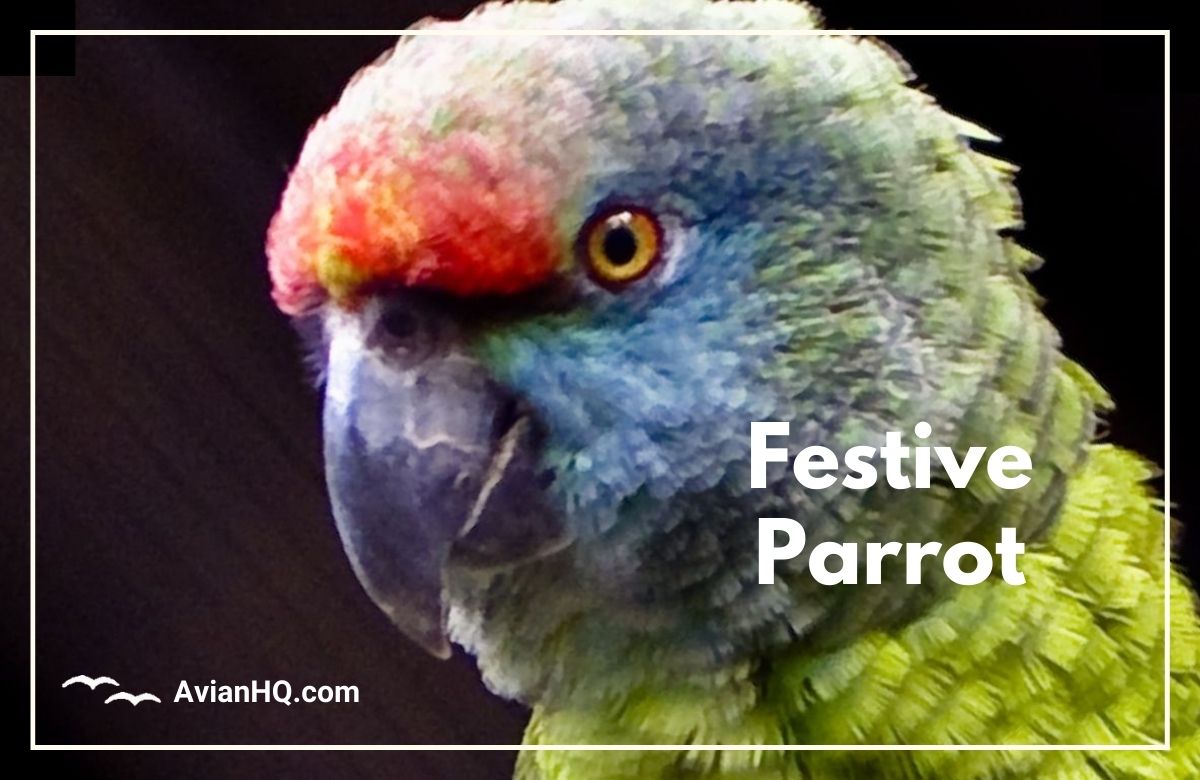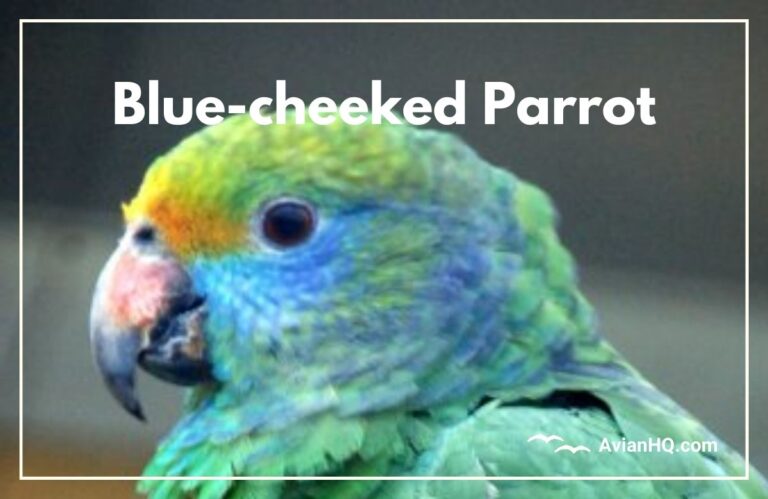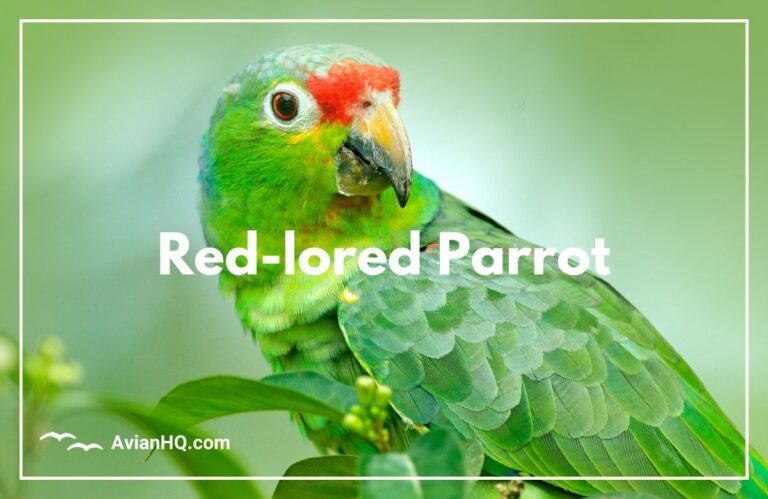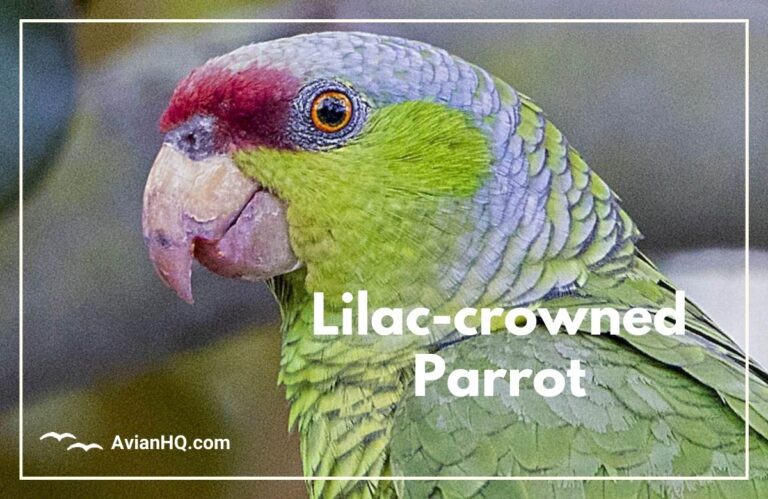Festive Parrot (Amazona festiva)
The bright colors and loud calls of parrots make them popular birds. If you’re interested in parrots, you should learn about the Festive Parrot. This tropical bird has green feathers accented with vibrant red, blue, and yellow.
When you see a Festive Parrot, you’ll notice its colorful feathers right away. But there’s more to this bird than meets the eye. Festive Parrots have interesting behaviors, eat unique diets, and play important roles in their forest homes. Sadly, Festive Parrot populations are declining. You can help by learning more about these animals and supporting conservation efforts.
Identifying Traits of the Festive Parrot
Festive Parrots are medium-sized, measuring 13-14 inches (34-35 cm) long. They weigh an average of 13 ounces (370 grams). Their main body feathers are bright green. The feathers around their eyes are blue. They have a red stripe above their beaks. Additional red feathers cover their lower backs and rumps. Their tail feathers have yellow tips.
“The bright red and blue feathers make the Festive Parrot easy to spot among the green of the forest canopy!”
Two subspecies of Festive Parrots exist:
- Northern Festive Parrots have more red on their foreheads and heads. They also have blue feathers on their cheeks.
- Southern Festive Parrots have darker red stripes above their beaks. Their cheeks are green.
Both subspecies have grayish-black beaks, orange eyes, and gray rings around their eyes.
History and Taxonomy
The Festive Parrot’s scientific journey began over 250 years ago. In 1758, Swedish scientist Carl Linnaeus first described the species in Volume 10 of his book Systema Naturae. He named the bird Psittacus festivus, grouping it with all other parrots under the genus Psittacus.
“Psittacus festivus” translates to “festive parrot” from Latin roots.
Linnaeus made a mistake, however, listing the Festive Parrot’s home as the “Indies” rather than South America.
Nearly 75 years later in 1830, French naturalist René Lesson assigned the Festive Parrot to its current genus, Amazona. The name Amazona honors the female warriors of Greek mythology.
Today, scientists recognize two Festive Parrot subspecies:
- Amazona festiva festiva inhabits forests along the Amazon River.
- Amazona festiva bodini occupies woodlands near the Orinoco River.
Both subspecies of this 35 cm (13.7 inch) long parrot populate regions of South America. But their distinctive plumage and geographic separation earned them separate classifications.
Physical Appearance
The Festive Parrot is a medium-sized bird, measuring 34-35 cm (13-14 inches) long. It weighs about 370 grams (13 ounces). Its main body feathers are bright green. This green color covers the head, back, chest, belly, and wings.
The area above and behind the Festive Parrot’s eyes is blue. Some blue feathers also partially cover the back of its head. The feathers on its cheeks are either green or blue depending on the subspecies.
Festive Parrots have dark red feathers between their eyes and beaks. These feathers form a stripes or bands above their grayish-black beaks. They also have red feathers on their lower backs, rumps, and at the base of their main tail feathers. Their tail tips are yellow.
The outer wings and flight feathers of the Festive Parrot are a dark violet-blue color. Its legs and feet are grayish like its beak. The iris or colored part of the Festive Parrot’s eyes is orange. A thin gray ring surrounds each eye.
Young Festive Parrots have duller versions of the adult plumage. Their lower backs and rumps only show small patches of red emerging among green feathers. Their tail bases also lack some red. Young birds’ eyes are brown rather than the orange of adults.
Native Habitat and Distribution
Festive Parrots live in northeastern South America. Their natural habitat consists of tropical lowland moist forests and woodlands. They reside primarily near major rivers like the Amazon and Orinoco.
The nominate subspecies, Amazona festiva festiva, inhabits the Amazon Basin. Its range extends through parts of Brazil, Peru, Colombia, Ecuador, Bolivia, and Venezuela.
Meanwhile, Amazona festiva bodini occupies areas near the Orinoco River. Its native region covers territories in eastern Colombia, southeastern Venezuela, and Guyana.
Both subspecies of Festive Parrots mainly stay below elevations of 500 meters (1,640 feet). But in Venezuela, some A. f. bodini parrots dwell in forests up to 1,000 meters (3,280 feet).
Festive Parrots typically stick close to water sources like rivers and swamps. But they may also stray into nearby grasslands and forests. Sometimes they even visit human plantations.
Diet and Feeding
In the wild, Festive Parrots eat a varied diet of seeds, nuts, fruits, berries, and leaf buds. Their favorite wild fruits include mangos and peach palms. They use their strong gray beaks to crack open nuts and seeds.
Festive Parrots exhibit social feeding behaviors. Small groups or pairs of birds will gather together to forage for foods. When the parrots locate a plentiful fruit tree or nut grove, larger flocks may congregate. Dozens of parrots chatter loudly among the branches as they fill up on their favorite foods.
“The Festive Parrot’s strong beak easily splits open palm nuts and even Brazil nuts, which are among the hardest seeds in the world!”
In captivity, these parrots eat a specially formulated pelleted base diet. This can be supplemented with limited amounts of nuts, chopped fruits, cooked beans, corn, and non-citrus vegetables like carrots. Care should be taken not to overfeed treat items.
Breeding and Reproduction
Festive Parrots form monogamous pairs during breeding season. They nest in tree cavities, often choosing palm trees. The female typically lays a small clutch of 2-3 eggs. She incubates the eggs herself for about 28 days while the male brings her food.
After hatching, the young parrots develop quickly compared to other birds. They fledge the nest at approximately 8 weeks old. The parents continue caring for them as they learn to fly and forage on their own. Juvenile Festive Parrots reach full adult colors by about 18 months old.
In captivity, pairs of Festive Parrots can be encouraged to breed by providing proper nesting sites. Providing food high in calcium and vitamin D3 also helps with egg production and development. However, the specific triggers for breeding in the wild remain unclear.
Behavior and Ecology
Festive Parrots display some interesting behaviors both individually and in groups. Wild birds generally live in monogamous pairs that remain together for life. Small flocks of up to 30 birds may also join together. These groups likely consist of mated pairs and their previous young.
Festive Parrots sleep together in communal roosts at night for safety. Their loud calls echo through the trees as they gather at dusk. In the mornings, the parrots set out in pairs or smaller parties to search for food.
These amazons appear to maintain resident territories instead of migrating. But some local seasonal movements may occur between wet and dry forests. More northern and southern populations could also intermingle at times.
Festive Parrots sometimes gather with other parrot species that share their habitat. They forage, travel, and roost among a lively flock of feathered friends! These interactions showcase the Festive Parrot’s energetic and social personality.
Conservation Status
In 2012, the International Union for Conservation of Nature (IUCN) declared the Festive Parrot a Vulnerable species. This means it faces a high risk of endangerment in the wild.
Major threats to the Festive Parrot include:
- Deforestation – Logging and land clearing destroy vital breeding and feeding habitat.
- Illegal pet trade – Poachers raid nests and trap parrots to sell.
- Climate change – Rising temperatures may alter forest ecology.
Exact wild population sizes remain unknown. But experts estimate Festive Parrot numbers are declining across their range in South America.
The Convention on International Trade in Endangered Species (CITES) regulates cross-border traffic of Festive Parrots. The species is listed under Appendix II which permits some regulated trade. More action is still needed to protect populations being decimated by the black-market pet industry though.
You can support Festive Parrot conservation by learning about these threats. Consider donating to nonprofit groups working to protect vital parrot habitats too. Together we can ensure Festive Parrots continue lighting up South American skies for decades to come!
Conclusion
The Festive Parrot stands out thanks to its bright green, red, and blue plumage. This medium-sized amazon makes its home in lowland South American forests near major rivers. Festive Parrots form lifelong bonds with their mates. They gather in noisy flocks at communal roosts and feeding sites.
Two subspecies of Festive Parrots exist, with some slight differences in coloring and range. But both face threats from deforestation and illegal wildlife trafficking. Festive Parrot numbers are believed to be decreasing across Brazil, Colombia, Venezuela and other countries.
By learning more about species like the Festive Parrot, you can help advocate for crucial conservation programs. Pay attention to opportunities to support habitat protection projects or responsible captive breeding efforts for vulnerable tropical birds. We all have a role to play in preserving precious biodiversity for generations to come.
Now whenever you see a bright flash of green and red overhead, watch closely. It just might be a marvelous Festive Parrot flock calling the rainforest home!







